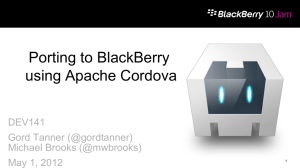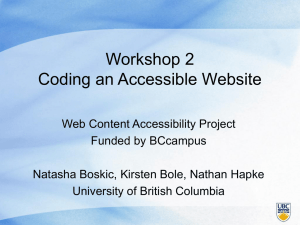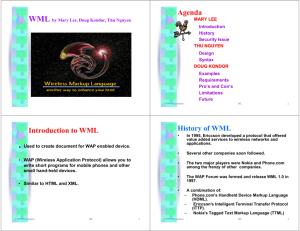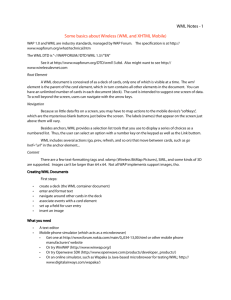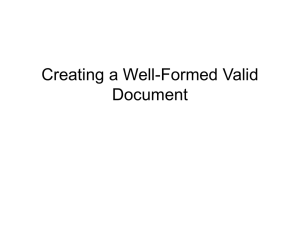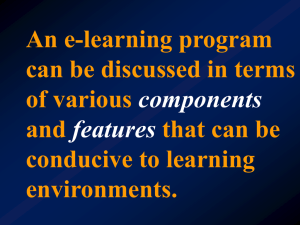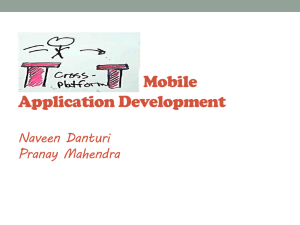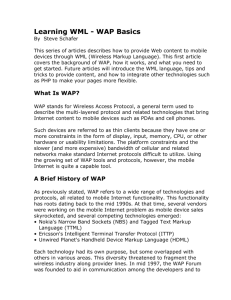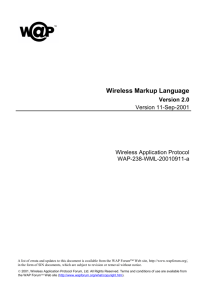Delivering Mobile Content
advertisement
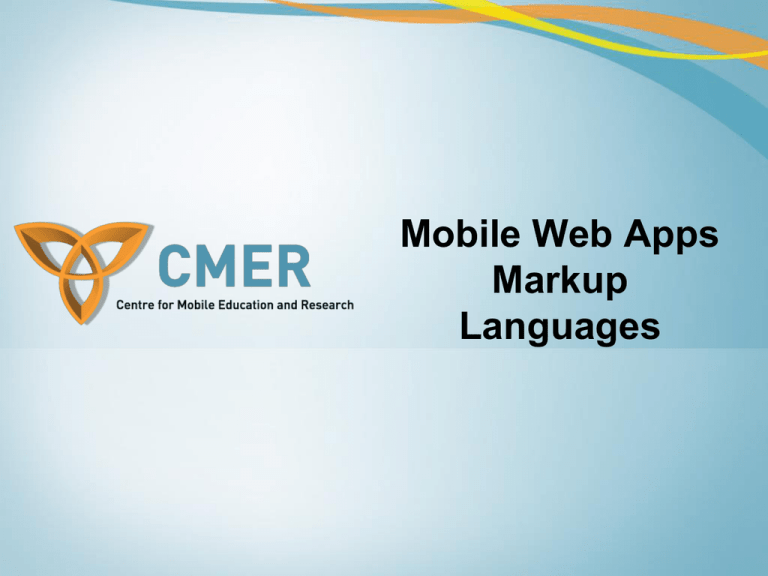
Mobile Web Apps Markup Languages Delivering Mobile Content to Mobile Devices When building mobile Web applications, how content is to be delivered to mobile devices is important Four potential approaches No changes to Web content Remove extra formatting Apply cascading Style Sheet Build custom mobile content Delivering Mobile Content: No Changes to Web Content • This approach does not require any changes to be made to regular Web content • A mobile browser (or microbrowser) optimizes Web content to properly be displayed on mobile devices – Web content is rendered by the mobile browser – Small Screen Rendering (SSR) and Medium Screen Rendering (MSR) introduced by Opera Software: render regular Web pages to properly fit on small screens (mobile phones) and medium-sized screens (PDAs) Delivering Mobile Content: Remove Extra Formatting • This approach does not require any changes to be done to the original design of the content • Remove any formatting that may consume too much memory on the device (i.e. table formatting, background images, etc.) – Faster loading of content – Less bandwidth Apply Cascading Style Sheet (CSS) • CSS is powerful language for attaching style to Web documents – It works with HTML to define how content is presented • This approach requires a specific CSS for mobile devices • The style sheet is designed to optimize content for mobile devices – i.e. optimized formatting Delivering Mobile Content: Build Custom Mobile Content • This approach requires the development of custom mobile content • Create a mobile version of the content to be displayed properly on mobile devices – Requires testing of content on as many mobile devices as possible, – Maintaining different content versions of an application may become time consuming Delivering Mobile Content: Summary Approach Content is controlled by No Changes to Web Content Mobile device (via microbrowser) Remove Extra Formatting Mobile device (via microbrowser) Apply Cascading Style Sheet (CSS) Content author Build Custom Mobile Content Content author Understanding Wireless Markup Language (WML) • WML replaced HDML – HDML was intended to display Web content for handheld computers, smartphones, etc. – HDML was introduced in 1996 by Unwired Planet (now Openwave) • WML pages have the extension *.WML • WML pages are called DECKS • They are constructed as a set of CARDS, related to each other with links • WML page must have at least one CARD Understanding the WML (continued) • When a WML page is accessed from a mobile phone, all the cards in the page are downloaded from the WAP server • Navigation between the cards is done by the phone computer - inside the phone - without any extra access trips to the server Common WML Elements Deck/Card Elements Wml card template head access meta Event Elements Do ontimer onenterforward onenterbackward onpick onevent postfield Tasks Go prev refresh noop Variables Setvar User input Input select option optgroup fieldset Anchors, Images, and Timers a anchor img timer Text Formatting br p table tr td WML Example 1: Overview <?xml version="1.0"?> <!DOCTYPE html PUBLIC "-//WAPFORUM//DTD WML 2.0//EN" “http://www.wapforum.org/dtd/wml20.dtd" > <wml> <card title=“Example"> <p> This is a paragraph </p> <p> This is another<br/>with a line break </p> </card> </wml> WML Example 2: Timer <?xml version="1.0"?> <!DOCTYPE html PUBLIC "//WAPFORUM//DTD WML 2.0//EN" “http://www.wapforum.org/dtd/w ml20.dtd" > <wml> <card ontimer="test.wml"> <timer value="30"/> <p>Some Message</p> </card> </wml> A WML card can be set up to use the timer function of WML. The time unit of the timer is 1/10 of a second. The example below will display a message for 3 seconds, and then take you to the file "test.wml": Building WML Documents • There are several tools that can be used to create WML – Nokia Mobile Internet Toolkit – Openwave Mobile SDK – Microsoft Mobile Internet Toolkit with Microsoft .NET Framework • Building mobile Web applications is not tied to WAP and WML • New challenging models challenge the future of WAP – Example: J2ME, XHTML Basic Creating WML using Openwave SDK 5.1 Example • Click on File New WML File Creating WML using Openwave SDK 5.1 (continued) • Enter the following WML code Notation for writing comments • In the Address field, enter the location of the WML file – Example: C:\MyFirstWML\WMLExample.wml Creating WML using Openwave SDK 5.1 (continued) • Openwave Emulator used to display Example 1 You may change the emulator device by clicking on Simulator Select Device (i.e. Siemens S45 5.0.1) WML Cards Example • In this example, three cards are used Canada Ontario Quebec British Columbia Nova Scotia Manitoba Alberta New Brunswick Prince Edward Island Newfoundland and Labrador Saskatchewan Northwest Territories Yukon Nunavut Ontario Toronto Mississauga Milton Kitchener Waterloo Guelph Burlington London Oakville Niagara Falls Ottawa Oshawa Brampton Kingston Hamilton Toronto Population Time Zone Area Code WML Cards Example (continued) WML Cards Example (continued) • Using <a> to link the first two cards together WML Cards Example (continued) • Using <a> to link the second and third cards together . . . WML Tables Example WML Input Fields Example WML Variables • WML does not support user input – Developers must use other scripting languages (i.e. WMLScript) to manipulate data (i.e. user input) • When a user switches from card to card in a deck, we need to store data in variables. WML variables are case sensitive. • Specify a Variable with the setvar Command • The following example will create a variable named i with a value of 500: <setvar name="i" value="500"/> WML Variables Example WML Variables Example (continued) The <do> element: <do> ... </do> The first card has a <do> element that defines an event to be triggered. The type="accept" attribute of the <do> element causes the label="Answer" to be displayed in the lower left corner of the display. WML Options Group XHTML Basic • XHTML Basic is a subset of XHTML – designed for mobile devices – introduced by the W3C • XHTML Basic versus WML – Using XHTML Basic, one does not have to create multiple version of a mobile Web application – Mobile Web application developed using XHTML can be viewed by regular browsers (i.e. Internet Explorer) or microbrowsers – Reduces amount of time needed to build a mobile Web application (only have to maintain a single version) Supported HTML Elements by XHTML Basic Structure body, head, html, title Text abbr,acronym,address,blockquote,br,cite,code, dfn,div,em,h1,h2,h3,h4, h5,h6,kbd, pn,pre,q,samp,span,string,var Hypertext a List dl,dt,dd,ul,li Forms form,input,label,select,option,textarea Tables caption,table,td,tr,th Image img Object object,param Meta Info meta Link link Base base Valid XHTML Basic Syntax • XHTML documents must – Contain valid DOCTYPE definition (DTD) – Have a root element must be html – Have a root element must contain XHTML default namespace XHTML Basic Example XHTML Basic Supported Features • XHTML Basic does not support WMLScript – One has to manually call a WML file that contains a WMLScript • XHTML supports the use of Cascading Style Sheets (CSS) – CSS are used to apply common formatting XHTML Mobile Profile • eXtensible HyperText Markup Language Mobile Profile (XHTML MP) is – a subset of XHTML – simply XHTML Basic plus additional elements and attributes from the XHTML full version • The current version of XHTML MP is 1.2 Understanding XHTML MP Document Structure • Each markup document contains a DTD – A Document Type Definition specifies the syntax (grammatical structure) of a markup document • XHTML MP is XML-based, which means – DOCTYPE must be defined, – Documents must be well formed – All tags are case sensitive, – All tags must be properly closed, – Elements must be properly nested, – Elements and attributes must be in lowercase, – Attributes must be enclosed in quotes, – All attributes must have values, Supported HTML Elements in XHTML MP • Most of the common HTML elements are supported by XHTML MP • However, XHTML MP does not support many features in WML – For example: • The concept of decks and cards is not present • Unlike WML, XHTML-MP does not support client-side variables • Using XHTML-MP, one must submit a form using a submit button. Using WML, it is possible to submit a form using a link. • Unlike WML, XHTML-MP does not support timers Some Common XHTML MP Syntax Errors • Nested elements – Incorrect <p><b>Welcome to XHTML MP <i>good</b>.</i></p> – Correct <p><b>Welcome to XHTML MP <i>good</i>.</b></p> • Attributes must be enclosed in quotes – Incorrect <div align=center>Welcome to XHTML MP</div> – Correct <div align=“center”>Welcome to XHTML MP</div> Some Common XHTML MP Syntax Errors (continued) • Do not minimize attributes – Incorrect <select> <option value=“0” selected>No</option> <option value=“1”>Yes</option> <select> – Correct <select> <option value=“0” selected=“selected”>No</option> <option value=“1”>Yes</option> <select> Supported HTML Elements by XHTML MP Structure Text Presentation Style Sheet Hypertext List Basic Forms body, head, html, title abbr, acronym, address, blockquote, br, cite, code, dfn, div, em,h1, h2, h3, h4, h5, h6, kbd, p, pre, q, samp, span, strong, var b, big, hr, i, small style element and style attribute a dl, dt, dd, ol, ul, li form, input, label, select, option, textarea, fieldset, optgroup Basic Tables Image Object Meta Info. Link Base caption, table, td, th, tr img object, param meta link base Be Prepared • Have an Internet Information Services (IIS) installed and ready to use • Have Adobe ColdFusion MX or 8 installed and ready to use – IIS should support ColdFusion (i.e. CFM pages) • Microsoft Visual Studio (2005 or 2008) installed Prepare BlackBerry Environment • Download – BlackBerry® Device Simulators v4.6.0.150 (9000) • Download file into a local folder (i.e. C:\BlackBerry\Simulators\9000) • Download – BlackBerry® Email and MDS Services Simulator Package v4.1.2 (Bundle 17) • Download file into a local folder (i.e. C:\BlackBerry\MDS Steps for running Mobile Web Applications on BlackBerry Simulators • Before running any mobile Web application, it is important to prepare the proper BlackBerry environment – Run MDS Services • Click on Start Research In Motion BlackBerry Email and MDS Services Simulators 4.1.2 MDS – Run the BlackBerry Device Simulator v4.6.0.150 • Go to C:\BlackBerry\Simulators\9000\ and run 9000.bat 1. important 2. It is important to setup the Java environment on your PC to properly launch and run MDS Simulator. Certain MDS and Email Simulators may require different versions of Java Steps for running Mobile Web Applications on BlackBerry Simulators • After running MDS Services, the following command prompt should open • After running Device Simulator v4.6.0.150, the following window opens BlackBerry Device Characteristics BlackBerry Browser • BlackBerry Browser: included with every BlackBerry device First generation Supports simple Web page presentations and wirelessspecific content, Provides limited JavaScript, and CSS support Second generation Introduced a new rendering agent and JavaScript engine for greater support of Web standards, Supports HTML 4.01, CSS 2.1, and DOM Level 2 Ability to render most existing Web content Trackball • Most BlackBerry devices have a trackball • Trackballs are used to control the navigation (i.e. similar to a mouse) • BlackBerry devices with a trackball also include a Menu key to the left of the trackball • Older BlackBerry devices use a Trackwheel for control the navigation Menu Trackball Trackwheel Touch Screen • BlackBerry devices with SurePress touch screen, users are able to use their fingers to interact with applications on the device Picture is a courtesy of GSM MAG Keyboard • Keyboards are used to type text • BlackBerry users can use keyboards to also move around a screen (i.e. map) • Two types of keyboards: QWERTY or SureType Keyboard (continued) • QWERTY keyboard: similar to PC keyboards • SureType: Integrates a traditional phone keypad and a familiar QWERTY-style keyboard – SureType technology has the ability to predict words as users type MDS Connection Service • Designed to provide users with secure access to their organization’s intranets and access to the Internet • It is a component of the BlackBerry Enterprise Server (BES) that exists on the organization’s network behind a firewall • It acts as a proxy for the BlackBerry browser and makes requests on behalf of the browser. • It also optimizes the response to enhance network efficiency and display on smaller screens MDS Connection Service Security • To access a Web page, MDS Connection Service opens a connection to the Internet from within an organization • MDS Connection Service can use SSL and TLS protocols to encrypt communication over the Internet between BES and Web servers – Supports Triple DES Internet Service Browsing • Wireless service providers can use the BlackBerry Internet Service Browsing to offer BlackBerry device users access to the Internet without using BES • It acts as a proxy for the browser and makes requests on behalf of the BlackBerry browser • It optimizes content in the response for improving the efficiency and the display on smaller screens Internet Service Browsing Security • It does not support Triple DES • It is not designed to access intranets that are protected by firewalls • It allows users to access secure sites using HTTPS • Supports SSL and TLS
